1993 BUICK REGAL check engine light
[x] Cancel search: check engine lightPage 176 of 308
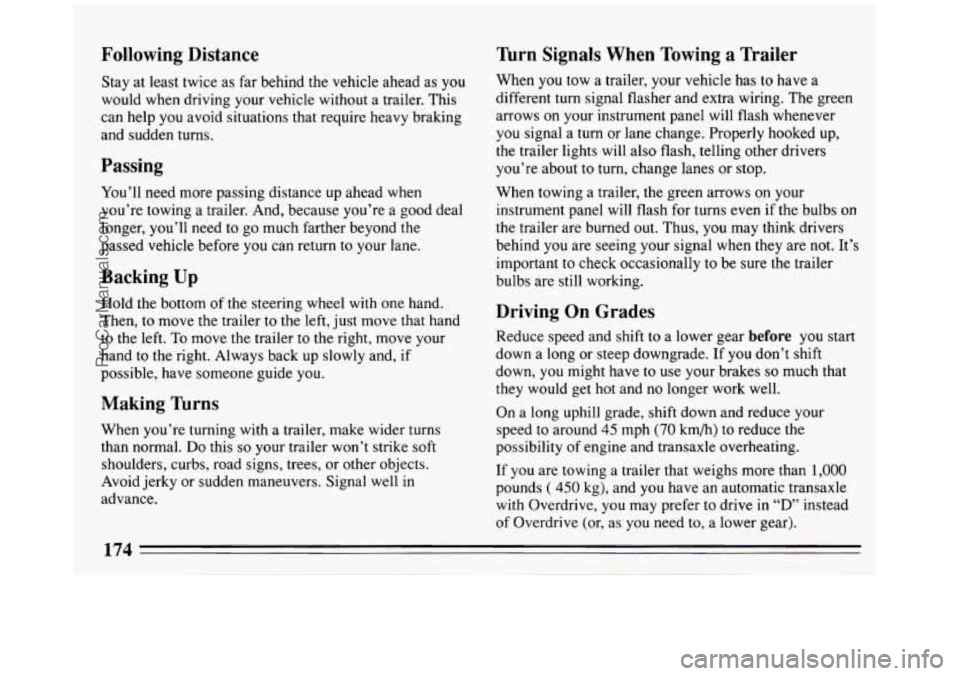
Following Distance
Stay at least twice as far behind the vehicle ahead as you
would when driving your vehicle without a trailer. This
can help you avoid situations that require heavy braking
and sudden turns.
Passing
You’ll need more passing distance up ahead when
you’re towing a trailer. And, because you’re a good deal
longer,
you’ll need to go much farther beyond the
passed vehicle before
you can return to your lane.
Backing Up
Hold the bottom of the steering wheel with one hand.
Then, to move the trailer to the left, just move that hand
to the left. To move the trailer to the right, move your
hand to the right. Always back up slowly and, if
possible, have someone guide you.
Making Turns
When you’re turning with a trailer, make wider turns
than normal.
Do this so your trailer won’t strike soft
shoulders, curbs, road signs, trees, or other objects.
Avoid jerky or sudden maneuvers. Signal well in
advance.
firn Signals When Towing a Trailer
When you tow a trailer, your vehicle has to have a
different turn signal flasher and extra wiring. The green
arrows on your instrument panel will flash whenever
you signal a turn or lane change. Properly hooked up,
the trailer lights will also flash, telling other drivers
you’re about to turn, change lanes or stop.
When towing a trailer, the green arrows
on your
instrument panel will flash for turns even if the bulbs on
the trailer are burned out.
Thus, you may think drivers
behind you are seeing your signal when they are not.
It’s
important to check occasionally to be sure the trailer
bulbs are still working.
Driving On Grades
Reduce speed and shift to a lower gear before you start
down a long or steep downgrade. If
you don’t shift
down, you might have to use your brakes
so much that
they would get hot and no longer work well.
On a long uphill grade, shift down and reduce your
speed to around
45 mph (70 km/h) to reduce the
possibility of engine and transaxle overheating.
If you are towing a trailer that weighs more than
1,000
pounds ( 450 kg), and you have an automatic transaxle
with Overdrive, you may prefer to drive in
“D” instead
of Overdrive
(or, as you need to, a lower gear).
174
ProCarManuals.com
Page 184 of 308
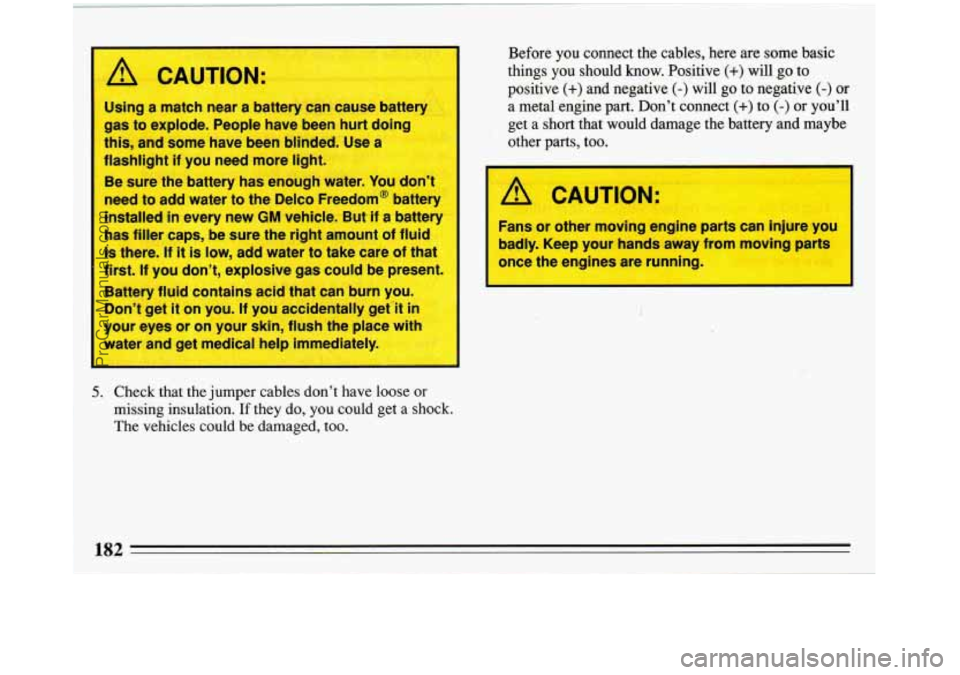
1
I A CAUTION:
Using a match near a battery can cause battery
this, and some have been blinded. Use a
I gas to explode. People have been hurt doing
I
I flashlight if you need more light.
Be sure the battery has enough water. You don‘-
need to add water
to the Delco Freedom@ battery
installed
in every new GM vehicle. But if a battery
has filler caps, be sure the right amount of fluid
is there. If it is low, add water to take care of that
First. If you don’t, explosive gas could be present.
Battery fluid contains acid that can burn you.
Don’t get
it on you. If you accidentally get-it in
your eyes or on your skin, flush the place with
water and get medical help immediately.
1 I
5. Check that the jumper cables don’t have loose or
missing insulation. If they do, you could get a shock.
The vehicles could
be damaged, too.
I
Before you connect the cables, here are some basic
things
you should know. Positive (+) will go to
positive
(+) and negative (-) will go to negative (-) or
a metal engine
part. Don’t connect (+) to (-) or you’ll
get a short that would damage the battery and maybe
other
parts, too.
I A CAUTION:
Fans or other moving engine parts can injure you
badly. Keep your hands away from moving parts
I once the engines are running.
l 182
ProCarManuals.com
Page 222 of 308

Before closing the hood, be sure all the filler caps are on
properly.
Then just pull the hood down and close it firmly.
Engine Oil
If the “LOW OIL” light on the instrument panel comes
on, it means you need to check your engine oil level
right away.
You should check your engine oil level
regularly, the light
is an added reminder. It’s
a good idea to check your engine oil every time you
get fuel.
In order to get an accurate reading, the oil must
be warm and the vehicle must be
on level ground.
The dipstick is located near the front and center
of the
engine compartment.
Turn
off the engine and give the oil a few minutes to
drain back into the oil pan. If you don’t, the oil dipstick
might not show the actual level.
ProCarManuals.com
Page 230 of 308
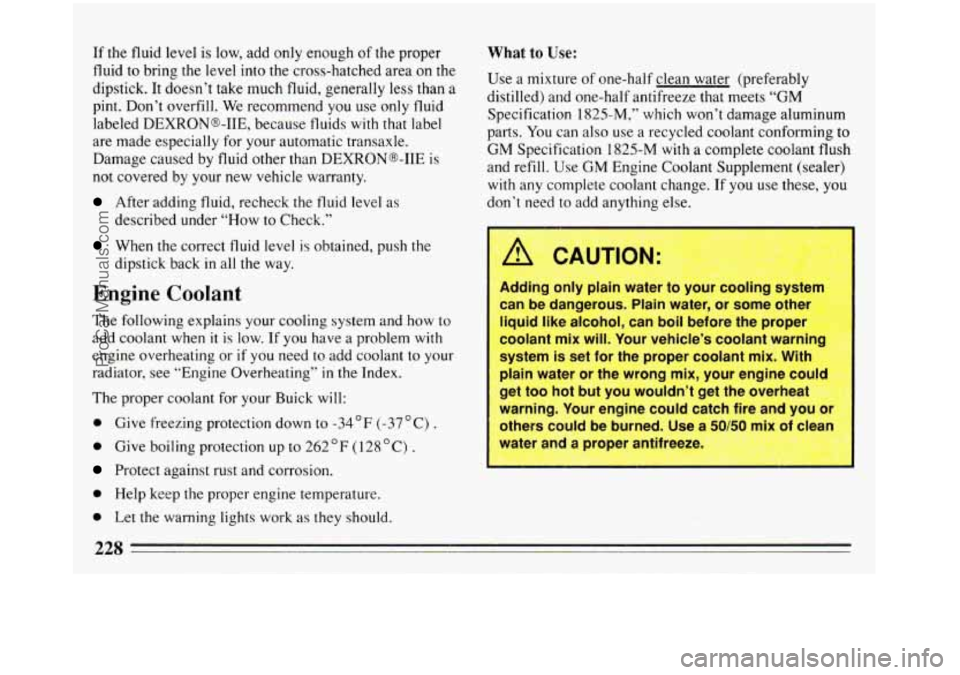
If the fluid level is low, add only enough of the proper
fluid to bring the level into the cross-hatched area on the
dipstick. It doesn’t take much fluid, generally less than a
pint. Don’t overfill. We recommend you use only fluid
labeled DEXRONB-IIE, because fluids with that label
are made especially for your automatic transaxle.
Damage caused by fluid other than DEXRONB-IIE is
not covered by your new vehicle warranty.
After adding fluid, recheck the fluid level as
described under “How
to Check.”
When the correct fluid level is obtained, push the
dipstick back in all the way.
Engine Coolant
The following explains your cooling system and how to
add coolant when
it is low. If you have a problem with
engine overheat.ing or if you need to add coolant to your
radiator, see “Engine Overheating”
in the Index.
The proper coolant for your Buick will:
0 Give freezing protection down to -34OF (-37OC) .
0 Give boiling protection up to 262 OF (128 “C) .
Protect against rust and corrosion.
0 Help keep the proper engine temperature.
0 Let the warning lights work as they should.
What to Use:
Use a mixture of one-half clean water (preferably
distilled) and one-half antifreeze that meets
“GM
Specification 1825-M,” which won’t damage aluminum
parts. You can also use a recycled coolant conforming to
GM Specification 1825-M with a complete coolant flush
and refill. Use GM Engine Coolant Supplement (sealer)
with any complete coolant change. If you use these, you
don’t need to add anything else.
can be aangerous. Plain water, or some other
liquid like alcohol, can boil before the proper
coolant mix will. Your vehicle’s coolant warning
system is set for the proper coolant mix. With
plain water or the wrong mix, your engine could
get too hot but you wouldn’t get the overhe-”
warning. Your engine could catch fire and
yuu or
others could be burned. Use a 50/50 mix of clean
water and a proper antifreeze.
G:~Z.+T~:, p:.t+d+s
228
ProCarManuals.com
Page 282 of 308
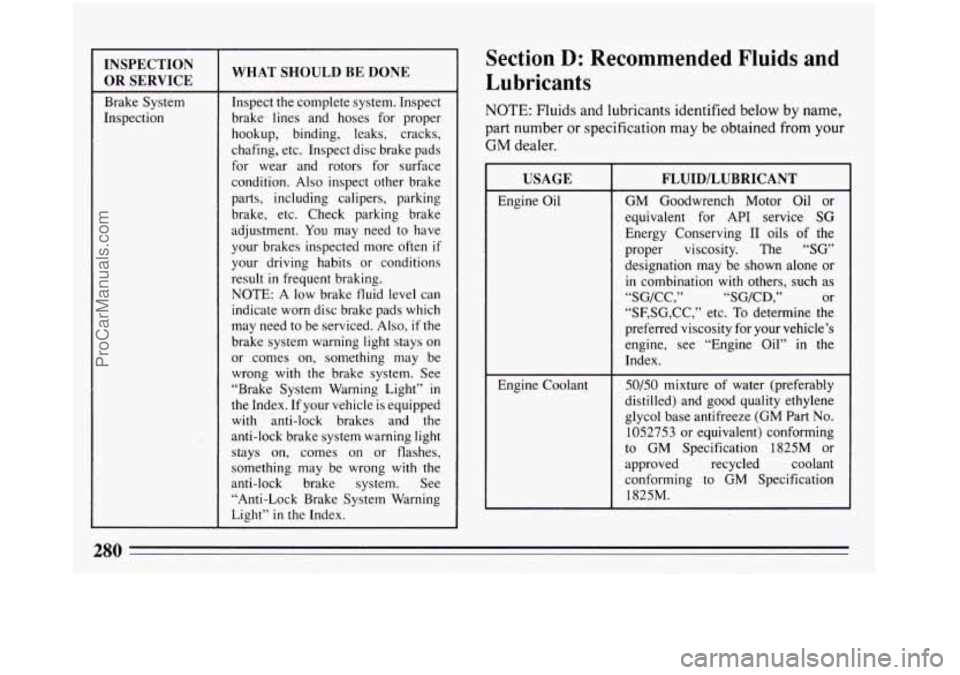
INSPECTION
OR SERVICE
Brake System
Inspection
WHAT SHOULD BE DONE
Inspect the complete system. Inspect
brake lines and hoses for proper
hookup, binding, leaks, cracks,
chafing, etc. Inspect disc brake pads
for wear and rotors for surface
condition. Also inspect other brake
parts, including calipers, parking
brake, etc. Check parking brake
adjustment. You may need to have
your brakes inspected more often
if
your driving habits or conditions
result
in frequent braking.
NOTE:
A low brake fluid level can
indicate worn disc brake pads which
may need to be serviced. Also, if the
brake system warning light stays on
or comes on, something may be
wrong with the brake system. See
“Brake System Warning Light”
in
the Index. If your vehicle is equipped
with anti-lock brakes and the
anti-lock brake system warning light
stays on, comes on or flashes,
something may be wrong with the
anti-lock brake system. See
“Anti-Lock Brake System Warning
Light”
in the Index.
Section D: Recommended Fluids and
Lubricants
NOTE: Fluids and lubricants identified below by name,
part number or specification may be obtained from your
GM dealer.
USAGE
Engine Oil
Engine Coolant
FLUID/LUBRICANT
GM Goodwrench Motor Oil or
equivalent for API service SG
Energy Conserving I1 oils of the
proper viscosity. The “SG”
designation may be shown alone or
in combination with others, such as
“SG/CC,” “SG/CD,”
or
“SF,SG,CC,” etc. To determine the
preferred viscosity for your vehicle’s
engine, see “Engine Oil” in the
Index.
50/50 mixture of water (preferably
distilled) and good quality ethylene
glycol base antifreeze (GM Part
No.
1052753 or equivalent) conforming
to
GM Specification 1825111 or
approved recycled coolant
conforming to
GM Specification
1825M.
ProCarManuals.com
Page 296 of 308
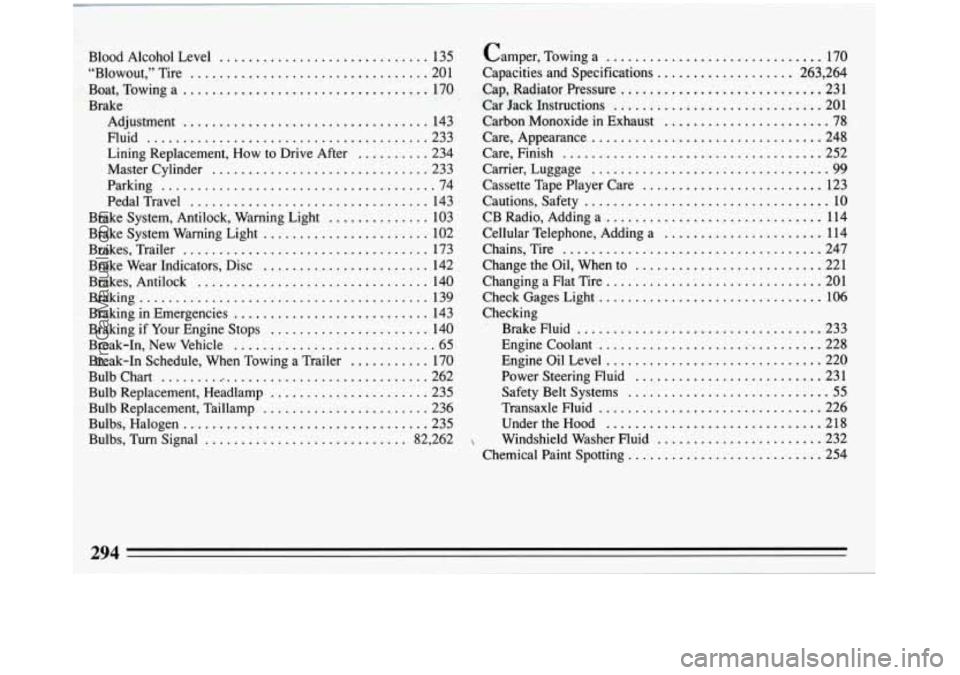
......................
?.'rrrrir.rr.*..s ..r.. *rrrlr)ry)r* 14p A ..
..... * ......... L . li e 0 $ 1 .... . i., . 5 ; ....... ?. . * .
Camper. Towing a .............................. 170
Capacities and Specifications ................... 263. 264
Car Jack Instructions ............................. 201
Carbon Monoxide in Exhaust ....................... 78
Care. Appearance ................................ 248
Care. Finish .................................... 252
Carrier. Luggage ................................. 99
Cassette Tape Player Care ......................... 123
Cautions. Safety .................................. 10
Cellular Telephone. Adding a ...................... 114
Chains. Tire .................................... 247
Changing a Flat Tire ............................... 201
Checking Cap. Radiator Pressure
............................ 231
CB Radio. Adding a .............................. 114
Change the Oil. When to .......................... 221
Check Gages Light ............................... 106
Brake Fluid .................................. 233
Engine Coolant ............................... 228
Engine Oil Level .............................. 220
Power Steering Fluid .......................... 231
Safety Belt Systems ............................ 55
Transaxle Fluid ............................... 226
Under the Hood ............................... 218
Windshield Washer Fluid ....................... 232
Chemical Paint Spotting ........................... 254
.
ProCarManuals.com
Page 301 of 308
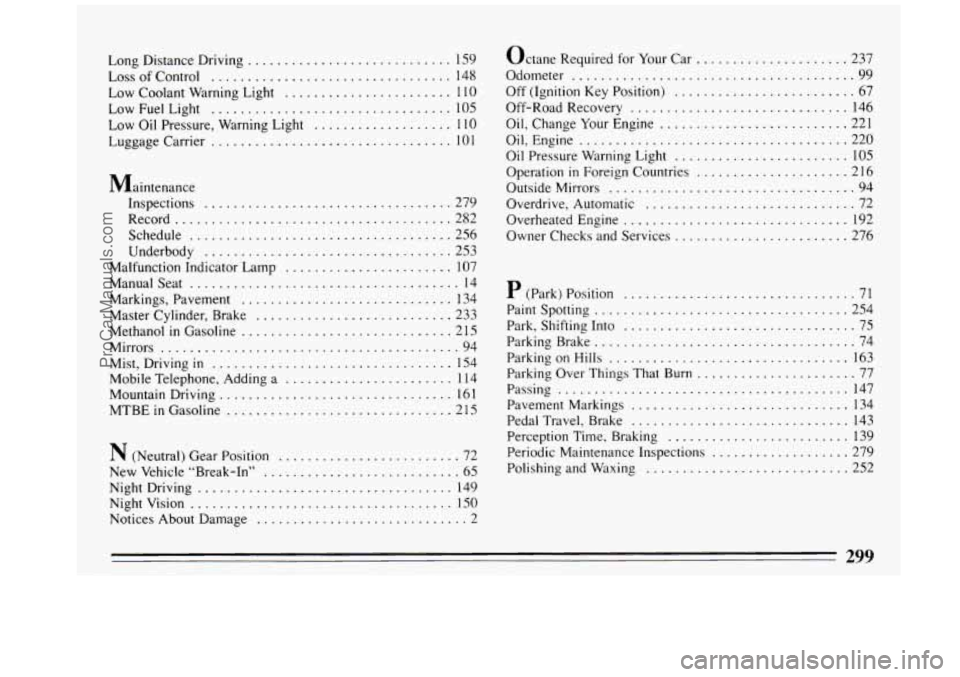
Long Distance Driving ............................ 159
LossofControl
................................. 148
Low Coolant Warning Light
....................... 110
Low Fuel Light ................................. 105
Low Oil Pressure. Warning Light ................... 110
Luggage Carrier ..............................
Maintenance
Inspections
.............
Record .................
..................
..................
. . 101
... 279
... 282
Schedule
.................................... 256
Underbody
.................................. 253
Malfunction Indicator Lamp
....................... 107
Manualseat
..................................... 14
Markings. Pavement
............................. 134
Master Cylinder. Brake
........................... 233
Methanol
in Gasoline ............................. 215
Mirrors
......................................... 94
Mist, Driving
in ................................. 154
Mobile Telephone, Adding a
....................... I14
Mountain Driving
................................ 16 1
MTBE in Gasoline ............................... 215
N (Neutral) Gear Position ......................... 72
New Vehicle “Break-In”
........................... 65
NightDriving ................................... 149
Nightvision
.................................... 150
Notices About Damage
............................. 2 Octane
Required for Your Car
..................... 237
Odometer
....................................... 99
Off (Ignition Key Position) ......................... 67
Off-Road Recovery
.............................. 146
Oil. Change Your Engine .......................... 221
Oil. Engine
..................................... 220
Oil Pressure Warning Light
........................ 105
Operation in Foreign Countries ..................... 216
Outside Mirrors
.................................. 94
Overdrive, Automatic
............................. 72
Overheated Engine
............................... 192
Owner Checks and Services
........................ 276
P (Park) Position ................................ 71
Paint Spotting
................................... 254
Park. Shifting Into
................................ 75
Parking Brake
.................................... 74
Parking on Hills
................................. 163
Parking Over Things That Burn
...................... 77
Pavement Markings
.............................. 134
PedalTravel, Brake
.............................. 143
Perception Time, Braking
......................... 139
Periodic Maintenance Inspections
................... 279
Polishing and Waxing
............................ 252
Passing
........................................ 147
299
ProCarManuals.com
Page 302 of 308

Power Antenna Cleaning
............................. 124
DoorLocks
................................... 61
Mirrors
...................................... 94
Seat Controls
.................................. 15
Steering
..................................... 144
Steering Fluid
................................ 231
Windows
..................................... 79
Pregnancy. Use of Safety Belts During
................ 33
Pressure. Tire ................................... 241
Problems on the Road
............................ 177
Proper Safety Belt Usage. for Adults
.................. 26
Publications Order Form
.......................... 291
Publications. Service
............................. 288
Push-Starting Your Car
........................... 180
R (Reverse) Gear Position ......................... 71
Racing. Shifting When Your Engine is
................ 79
Radiator Pressure Cap ............................ 231
Radio. Two-way. Adding
a ........................ 1 14
Radio Systems
.................................. 1 13
Rain. Driving
in ................................. 152
Reaction Time
in Braking ......................... 139
Reading Lights
................................... 93
Rear Seat Console and Pass-Through
................. 98
Rear Window Defogger
........................... 113
Reclining Front Seatbacks
.......................... 16
Recommended Fluids and Lubricants
................ 280
Radiator Overheating ............................. 192 Recovery.
Off-Road
.............................. 146
Recreational Vehicle. Towing
a ..................... 170
Remote Keyless Entry System
....................... 62
Remote Trunk Release
............................. 61
Replaceable Light Bulbs .......................... 262
Replacing Brake System Parts
...................... 234
Replacing Safety Belts ............................. 56
Replacing Wheels ............................... 246
Reporting Safety Defects
.......................... 287
Restarting Your
Car When It’s Moving ................ 79
Restraint. Child
.................................. 42
Restraint Systems. Checking Your
.................... 55
Restraints. Head .................................. 17
Reverse Gear Position
.............................. 71
“Riding” the Brakes
.............................. 139
Roads. Hill and Mountain
.......................... 161
Rotation. Tire
................................... 242
Run (Ignition Key Position) ......................... 67
Running Lights. Daytime
........................... 92
Replacing
Tires
................................. 244
Roadsigns
..................................... 128
Rocking Your Vehicle
............................ 170
Running Your Engine While You’re Parked
............ 77
Safety Belt Care
................................ 251
Safety Belt Extender
.............................. 55
Safety Belt Reminder Light ......................... 25
Safety Belt Replacement ............................ 56
Safety Belt Usage by Adults
........................ 26
300
ProCarManuals.com